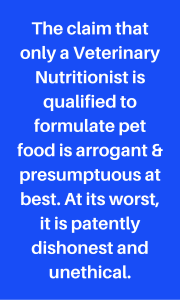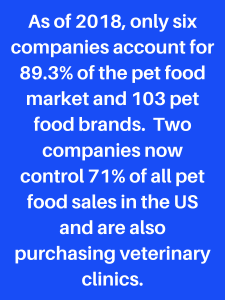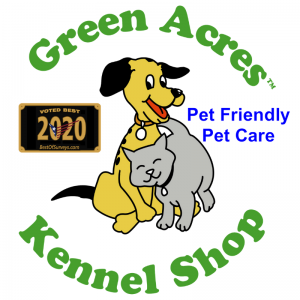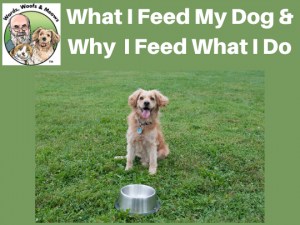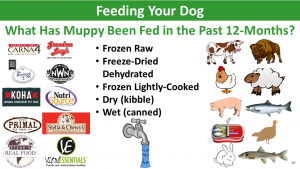 < This article was previously published in four parts in the MAY, JUNE, JULY, and AUGUST 2021 issues of Downeast Dog News>
< This article was previously published in four parts in the MAY, JUNE, JULY, and AUGUST 2021 issues of Downeast Dog News>
< Updated 23FEB22 >
< A short link for this page – http://bit.ly/PetNut-Opt-Cost-Con >
One of my favorite authors and experts on pet nutrition is animal nutritionist Dr. Richard Patton. I recently interviewed him on The Woof Meow Show [ FMI – http://bit.ly/WfMw2wPattonAPR21 ]. I appreciate that Dr. Patton can break down a complex subject like pet nutrition into some basic principles. When he first appeared on the show in April of 2016, he stated, “You can have convenience and economy, or you can have best nutrition. You can’t have all of those things.” I’ll break down that statement to help you evaluate what you feed your pets in this post.
What Is Best Nutrition?
If you ask any person to define optimal nutrition for a person or any other animal, you will likely get a multitude of contradicting opinions. Whether you believe every animal was placed on earth by a creator or that it exists due to evolution, it is clear that each species developed to find and consume nutrients that ensured their survival naturally. Since these species were evolving as humans evolved, they discovered their optimal source of nutrition without human intervention.
evolution, it is clear that each species developed to find and consume nutrients that ensured their survival naturally. Since these species were evolving as humans evolved, they discovered their optimal source of nutrition without human intervention.
Both the domestic dog and cat evolved over tens of thousands of years from carnivorous predators. The ancestors of the dog and cat were animals that hunted and survived by consuming other living species that were their prey. The prey they ate were comprised mainly of water, fat, and protein, basically meat. These meals were often consumed fresh, although caching of food to eat later also occurred. When times were tough, the dog also adapted to survive as a scavenger. However, our pets’ closest living wild relatives often still survive by eating prey animals. Some of us have cats and dogs that will readily hunt, kill and consume a mouse if given the opportunity. It is the food mother nature provided for them.
I would not encourage anyone to turn their pets loose on wildlife or domestic livestock to get the food they need to survive. However, if we want to feed our pets the optimal diet nature intended, we need to provide them with fresh meat.
If we want to feed our pets an optimal diet, we have two choices. First, we can educate ourselves to make our pets food [ FMI – http://bit.ly/PetFoodMyths-Facts-4MAR21 ] or avail ourselves of the many commercial products now available. These include frozen raw diets, lightly cooked & frozen diets, and freeze-dried and dehydrated diets that primarily consist of meat. Canned diets composed of 90% or more meat are close to what our pets would choose for themselves; however, they are not as natural as non-cooked meat because they are cooked.
What Is ‘NOT’ Best Nutrition?
The most common type of pet food fed to cats or dogs is kibble or dry food. In full disclosure, it is also the biggest seller in my store. I also feed kibble to my dog along with many other types of food.
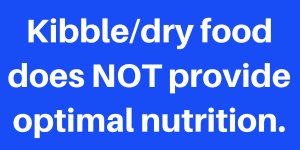 If you spend any time watching television, you know that dry pet food is advertised heavily. According to statista.com, in 2013, pet brands spent almost $891 million on advertising. That amounts to $2.4 million/day! Much of that advertising attempts to convince us that dry pet food or kibble is “natural” and has been developed to provide optimal nutrition for our pets. Based on what I know about how canines and felines evolved and just plain old common sense, I find the proposition that kibble is an optimal source of nutrition incredibly deceptive.
If you spend any time watching television, you know that dry pet food is advertised heavily. According to statista.com, in 2013, pet brands spent almost $891 million on advertising. That amounts to $2.4 million/day! Much of that advertising attempts to convince us that dry pet food or kibble is “natural” and has been developed to provide optimal nutrition for our pets. Based on what I know about how canines and felines evolved and just plain old common sense, I find the proposition that kibble is an optimal source of nutrition incredibly deceptive.
Pet food companies have formulated kibble to include ingredients that provide all of the nutrients that AAFCO standards state our pets need to survive. These ingredients are all put together in a “recipe.” They are then processed at high temperatures and pressures and formed into the brown/gray bits we know as kibble. If you read the ingredient list and look at what you place in the bowl of your pet, you will realize it is hardly equivalent to a diet of fresh meat. So, yes, pets survive eating kibble; however, there is a significant difference between surviving and thriving from a health perspective!
your pet, you will realize it is hardly equivalent to a diet of fresh meat. So, yes, pets survive eating kibble; however, there is a significant difference between surviving and thriving from a health perspective!
Dry pet food was developed because it is less expensive to make and sell and more convenient to sell and feed than fresh food. Dry pet food benefits the manufacturer, the distributor, the retailer, and the consumer; everyone but the pet. Nutritional science tells us that an optimal diet for our pets would consist of fresh food.
Kibble is a highly processed food. Human nutritionists tell us that we should eat fresh, whole foods (dairy, meat, fish, fruits, & vegetables) and severely limit or avoid eating processed foods. So why would our pets be any different?
Because of the low moisture content of kibble, it may even cause dehydration in our pets. [ FMI – https://bit.ly/Nut-Water ]
The Cost of Our Pets Nutrition
Many factors determine the actual cost of our pet’s nutrition. Direct costs relating to the food you purchase include; the quality of the ingredients used to make the food, marketing, the manufacturing process, and distribution and delivery. Indirect costs relate to convenience, more on that below, but most importantly, your pet’s health. In my experience, when you feed a pet a healthier diet, one that nature intended, they have far fewer visits to the veterinarian and live longer. So let’s look at some of these factors in more detail.
Ingredients
The ingredients used to make what our pets eat are the source of the nutrition they need to survive. Optimal nutrition comes from the highest quality ingredients that match our pet’s nutritional requirements; fresh meat. Meat is sold in varying qualities, from prime cuts suitable for human consumption to low-grade meat used in animal feed often classified as “inedible. As quality goes up, so does the price.
When you read the word “Chicken” on the ingredients list of your pet’s food, the company is probably hoping you are visualizing a roasted chicken fresh from the 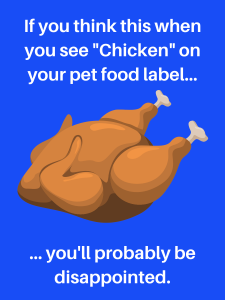 oven. To help that happen, some companies may even go so far as to put images of a roasted chicken on their packaging. Unfortunately, however, your vision is probably not anything like the chicken that went into that bag of kibble.
oven. To help that happen, some companies may even go so far as to put images of a roasted chicken on their packaging. Unfortunately, however, your vision is probably not anything like the chicken that went into that bag of kibble.
The chicken that goes into most pet food is leftovers from meat processed for people. This “chicken” is what is left after machines have stripped the muscle meat from the chicken’s skeleton. Because of how this chicken is processed, it might no longer be deemed edible for humans but can still be sold to be used in pet food. Many of the ingredients used in pet food are labeled as “feed grade” and are not considered edible by humans. If a dog were to eat a chicken running loose in your yard, they would get far more nutrition than they would from the “chicken” listed as an ingredient in many pet foods.
Some pet food companies make food from human-edible ingredients, especially in the frozen, freeze-dried, and lightly-cooked categories. However, these will be some of the most expensive pet foods due to the higher quality of the ingredients and the additional processing and regulatory requirements for food deemed fit for human consumption. That being said, they can be an excellent choice for providing optimal nutrition.
Marketing
Marketing pet food includes many things. One of the most obvious is advertising, especially television advertising. As I noted above, in 2013, the pet industry spent $2.4 million/day on advertising. When a product has a celebrity endorsement, it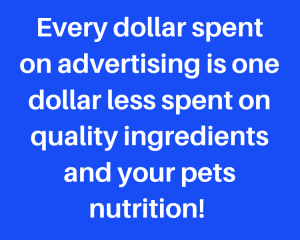 only adds to the marketing costs. Every dollar spent on marketing is one dollar less spent on quality ingredients!
only adds to the marketing costs. Every dollar spent on marketing is one dollar less spent on quality ingredients!
The average consumer may not know the deep discounts given to breeders, rescues, retailers, shelters, veterinary students, and veterinarians. But unfortunately, these also add to the cost you pay for your pet’s food.
Rescues and Shelters often receive food for free in exchange for sending every pet home with the corresponding brand of pet food. Breeders and pet stores may 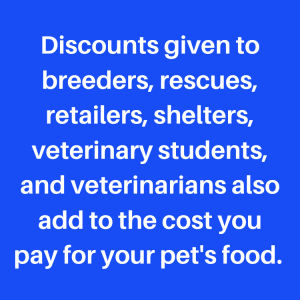 also receive deep discounts for only recommending or selling a specific brand. Two marketing programs that reduce the consumer’s cost are coupons and frequent buyer programs. However even, this type of marketing takes away from money that could be spent on better quality ingredients.
also receive deep discounts for only recommending or selling a specific brand. Two marketing programs that reduce the consumer’s cost are coupons and frequent buyer programs. However even, this type of marketing takes away from money that could be spent on better quality ingredients.
“Prescription” or veterinary diets are primarily about marketing, not nutrition. Some of the companies that sell these foods build brand loyalty early by offering veterinary students discounted or free food for their pets the entire time they are in school. These companies also often teach the one or two-day seminar on pet nutrition taught at veterinary schools. It is virtually identical to the class offered to retailers. No wonder many in the veterinary community have such blind loyalty to certain brands.
Another significant marketing cost billed back to the pet food consumer is the restrictions on how “prescription” diets are sold. None of these diets are a drug or medications requiring a prescription. The US Food and Drug Administration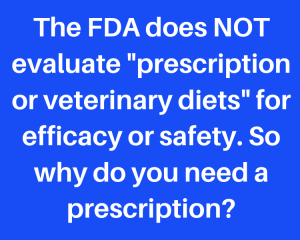 regulates drugs for humans and animals. However, the FDA has not classified “prescription” and veterinary diets as drugs, even though they are marketed as such. It frightens me that there has not been an independent evaluation that has proven these products are safe and effective for the medical conditions for which they are “prescribed.”. It would appear that the FDA is not concerned about the health of our pets.
regulates drugs for humans and animals. However, the FDA has not classified “prescription” and veterinary diets as drugs, even though they are marketed as such. It frightens me that there has not been an independent evaluation that has proven these products are safe and effective for the medical conditions for which they are “prescribed.”. It would appear that the FDA is not concerned about the health of our pets.
A “prescription” is required for these “specialty diets” because the manufacturers only allow them to be sold through a veterinarian as a way to control distribution and pricing. In marketing 101, you learn that you can dramatically increase the price of a product by restraining availability.
In 2019, TV station WJLA ABC7 News did a revealing and alarming story on “prescription” and veterinary diets. They had an independent laboratory analyze a variety of these diets and then analyzed and compared both groups. The analysis revealed that the “prescription” diets were often were made from lower quality ingredients. That is something no pet parent would expect, considering the higher prices charged for these products and how they are marketed. [ FMI – http://bit.ly/Nut-RXDiets-WJLA-24MAY19 ]
Convenience
Unless you have hours of free time, the convenience of what you feed your pet matters, I have a friend who feeds two dogs, two cats, and her family every morning before going to work. She wants pet food she can prepare quickly. I get that. However, we also need to factor in the health of our pets may suffer fas the price of our convenience. One of the reasons my wife and I downsized from having five dogs to one smaller dog was so that we could afford to always feed her the best.
Feeding Options for Our Pets
Below, I have listed various pet feeding options. Then, I will discuss the cost and convenience of each. Finally, I have listed those options that I believe provide the closest to optimal nutrition first.
Homemade Diets
When you choose to make your pet’s food, you have total control over the ingredients and method of preparation. If you select species-appropriate, fresh, 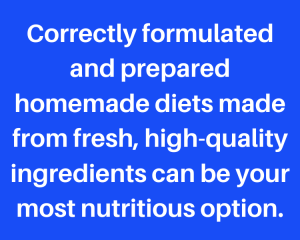 high-quality ingredients and prepare them properly, this can be your most nutritious option. Diets can be raw or cooked. First, however, you need to know what you are doing. I recommend that you work with a qualified animal nutritionist to develop your recipes or do lots of research and reading on your own. If you do the latter, look to using several resources, not just one.
high-quality ingredients and prepare them properly, this can be your most nutritious option. Diets can be raw or cooked. First, however, you need to know what you are doing. I recommend that you work with a qualified animal nutritionist to develop your recipes or do lots of research and reading on your own. If you do the latter, look to using several resources, not just one.
My wife made food for our Cairn Terrier, Gus, using recipes from a recognized veterinarian who focused on natural healing for several months. We discussed them with Gus’s regular veterinarian. Every Sunday, Paula spent 4 to 5 hours preparing a week’s worth of food, which took up one entire shelf in our refrigerator. That was for one small dog. In our experience, making food was more time-consuming than other options. Along with sourcing the ingredients, it also made it more costly. I might do this more when I retire, but it’s not practical for now.
Commercial Frozen Raw
We started learning about the benefits of feeding a raw diet in 1998 but were not comfortable making our own raw food, nor did we want to invest in the necessary equipment. When commercial frozen raw diets became available in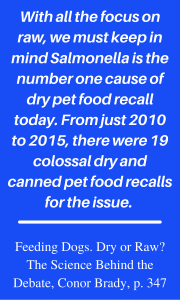 Maine in late 2001, we started feeding all five dogs raw in the morning and kibble in the evening. Feeding a commercial frozen raw diet is not inexpensive. Even though we were paying wholesale prices, it was not affordable for us to feed raw to our five dogs for both daily meals. Very pleased with the results of feeding raw, and with only two dogs, in 2004 we started feeding commercial raw almost exclusively.
Maine in late 2001, we started feeding all five dogs raw in the morning and kibble in the evening. Feeding a commercial frozen raw diet is not inexpensive. Even though we were paying wholesale prices, it was not affordable for us to feed raw to our five dogs for both daily meals. Very pleased with the results of feeding raw, and with only two dogs, in 2004 we started feeding commercial raw almost exclusively.
Just as with kibble, the quality of the ingredients used by raw food companies varies. Some are 100% meat, while others include a mixture of fruit and vegetables because of the natural micronutrients found in those items. It is essential to understand the company and its products when selecting a commercial raw food, just like any other type of pet food. All these factors affect the cost.
Commercial raw diets come in various form factors; chubs, patties, and chunks. In our experience, the chubs are the most economical and the least convenient. The chunks are almost as convenient as kibble, except for requiring freezer space, but are more expensive.
Commercial raw pet food companies are subject to the same regulations as companies that make kibble, including product safety. While there have been many allegations and concerns about salmonella and other pathogens in raw diets, it is rare compared to the incidence of salmonella being found in kibble.
For the past 18 months, I have been feeding Muppy a wide variety of brands and types of food [ FMI – https://bit.ly/WhatIFeedAndWhy ]. She is typically fed a commercial raw diet in the evening. She is usually provided a freeze-dried diet in 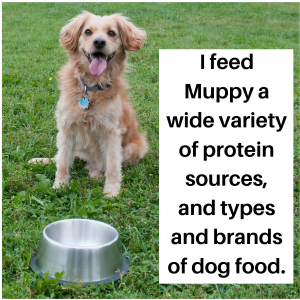 the morning. However, if we are evaluating a new wet or food or kibble, I may feed that in the morning as an alternative.
the morning. However, if we are evaluating a new wet or food or kibble, I may feed that in the morning as an alternative.
A week before I started writing this column in April of 2021, I began reading a new book on pet nutrition; Feeding Dogs. Dry or Raw? The Science Behind the Debate. It’s based on ten years of research and reviewing the scientific literature on various types of dog food, especially raw and kibble. I’ll be writing about the book in a future column and, based on what I’m learning, may move Muppy back to a diet that is entirely frozen raw or lightly cooked. [ FMI – https://bit.ly/BkRvwNOV2021 ]
Lightly-Cooked & Frozen
Lightly-Cooked frozen diets are one of the newest options available to pet owners. Like frozen raw, the quality of the product will vary with the quality of ingredients. I like and use one product made from human-grade ingredients; Beef Heart, Liver, and Round, Chicken Breast & Thigh, Egg, Lamb Shoulder,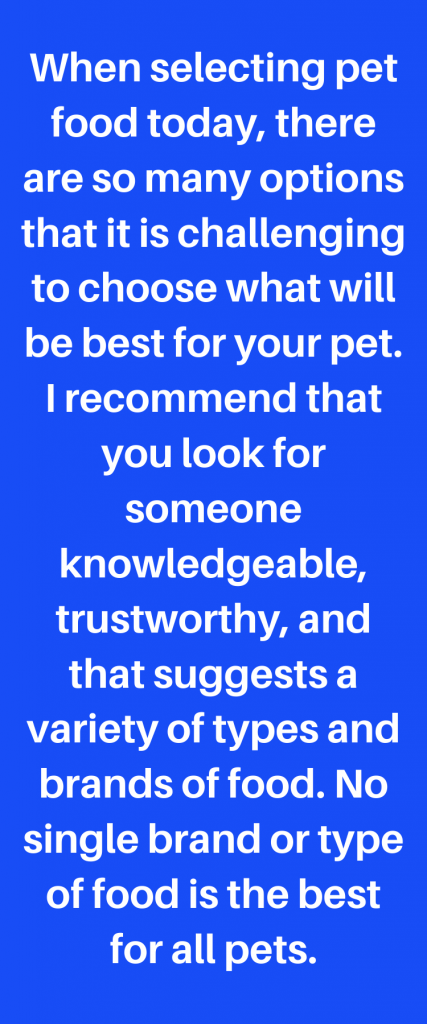 Turkey Heart & Thigh, Wild Salmon Filet, fruits, and vegetables. The combined ingredients are lightly cooked to destroy any pathogens. It’s as convenient to feed as any frozen product. Still, the use of human-edible ingredients makes it one of the most expensive options. [ FMI – http://bit.ly/WhyWeLikeMyPerfectPet ]
Turkey Heart & Thigh, Wild Salmon Filet, fruits, and vegetables. The combined ingredients are lightly cooked to destroy any pathogens. It’s as convenient to feed as any frozen product. Still, the use of human-edible ingredients makes it one of the most expensive options. [ FMI – http://bit.ly/WhyWeLikeMyPerfectPet ]
Commercial Freeze-Dried
Most of the companies that make frozen raw food also offer freeze-dried options. It is more convenient than frozen because it does not require freezer space, nor do you need to remember to thaw it in advance of feeding. It is the same as feeding frozen raw, but with the moisture removed. You just put it in a bowl and add water to rehydrate. However, because freeze-drying is a labor and energy-intensive process, it is one of the most expensive choices. Freeze-dried food can be as nutritious as frozen raw because it can be processed at a low temperature which does not destroy sensitive nutrients and enzymes. However, this depends on the companies process. Some companies use higher temperatures to maximize production, destroying some nutrients. For this reason, knowing about the companies processes will be critical.
Commercial Dehydrated
Dehydrated foods are equally convenient to freeze-dried and kibble. However, since the dehydration process involves high temperatures, these foods may not be as nutrient-rich as frozen raw or freeze-dried diets. They will be a better option than kibble, however. Cost-wise, when comparing actual feeding costs, these foods are often in a similar price range to freeze-dried diets.
Commercial “Fresh”
These are refrigerated “fresh” foods and are a relatively new category. You can find brands sold in the supermarket and online that are shipped to your home. I have reviewed the ingredient profiles on some of these foods and, in my opinion, consider them only marginally better than kibble. The options shipped to you will often be as expensive or more expensive than frozen raw, freeze-dried, frozen, and lightly cooked, which I believe are all more nutritious and natural options.
Commercial Wet/Canned/Pouched
Wet pet foods can be very convenient but are often too expensive for most people unless you have a small dog. In addition, all wet foods are cooked at high temperatures, so they may not be as nutrient-rich as previously discussed options. Finally, ingredients vary widely and can be as much as 95% meat or mostly soy protein. Reading and understanding the ingredients list and being familiar with the company making the products will be critical in your decision.
Commercial Dry/Kibble
More people feed their dog kibble than any other form of dog food. It is easy to purchase and is available at pet stores, feed stores, supermarkets, hardware stores, veterinary clinics, convenience stores, and even online. In addition, kibble is easy to store. All you need is a cool, dry place similar to where you store your food. For optimal nutrition and safety, kibble should be kept in an airtight container that you clean with soap and warm water every time you purchase additional food. I also suggest you keep the bag the food was in, as information on the bag will be necessary if the food is recalled or if you wish to return it for any reason.
Kibble is also one of the most convenient foods to use. It takes little time to measure the proper amount of food and pour it into your dog’s dish. However, substandard ingredients, high amounts of carbohydrates, and intense processing at high temperature and pressure make kibble the least natural and nutritious of any of our dog food choices. The cost of kibble varies widely with the quality of ingredients. For example, kibble is usually perceived as the most economical choice. However, being the least nutritious, we need to ask ourselves what is the actual cost when we factor in our pet’s quality of life, veterinary bills, and length of life.
Summary
When selecting pet food today, there are so many options that it is challenging to choose what will be best for your pet. I recommend that you look for someone knowledgeable, trustworthy, and who recommends a variety of types and brands of food. No single brand or type of food is the best for all pets.
choose what will be best for your pet. I recommend that you look for someone knowledgeable, trustworthy, and who recommends a variety of types and brands of food. No single brand or type of food is the best for all pets.
I opened this four-part series with the statement, “You can have convenience and economy, or you can have best nutrition. You can’t have all of those things.” Remember that your dog is a meat-eater and has no need for carbohydrates in its diet. I encourage you to feed the best food you can afford. I do not expect anyone to need a second mortgage to feed their pet. However, try to include as much fresh, species-appropriate food in their diet as you can. Even providing one fresh meal a week can make a difference. Lastly, commit to being an informed consumer; your dog depends on you.
Recommended Resources
Pet Nutrition – Pet Food Myths & Facts – No. 1, MYTH – Only a Board-Certified Veterinary Nutritionist is qualified to formulate pet food – http://bit.ly/PetFoodMyths-Facts-4MAR21
Our Pets Most Important Nutrient – Water – https://bit.ly/Nut-Water
An Exposé on Prescription Diets from WJLA ABC7 News – http://bit.ly/Nut-RXDiets-WJLA-24MAY19
What I Feed My Dog and Why I Feed What I Do – https://bit.ly/WhatIFeedAndWhy
Book Reviews – Knowledge to Enrich the Life of You and Your Dog – The Best Dog Books of 2021 – Feeding Dogs. Dry or Raw? The Science Behind The Debate by Conor Brady, Ph.D. – https://bit.ly/BkRvwNOV2021
Why We Like My Perfect Pet – http://bit.ly/WhyWeLikeMyPerfectPet
Shared Blog Post – The Scientific Benefits of Feeding Raw, All in One Place – https://bit.ly/IntvwDrConorBradyFeedingDogs
Richard Patton with link to 1-hour video –http://bit.ly/Video-Dr-Richard-Patton
Book Review – Ruined by Excess, Perfected by Lack – The paradox of pet nutrition by Richard Patton – http://blog.greenacreskennel.com/2016/03/16/book-review-ruined-by-excess-perfected-by-lack-the-paradox-of-pet-nutrition-by-richard-patton/
GAKS Philosophy on Pet Nutrition – http://bit.ly/GAKS_Nut_Phil
Which Companies Are Behind Your Pet’s Food? – http://bit.ly/PetFoodComp
 Podcasts-Two Conversations with Animal Nutritionist Dr. Richard Patton – http://bit.ly/WfMw2wPattonAPR21
Podcasts-Two Conversations with Animal Nutritionist Dr. Richard Patton – http://bit.ly/WfMw2wPattonAPR21
What We Feed Our Pets and Why, with – Don Hanson, Kate Dutra, and Linda Case – https://bit.ly/WfMw-WhatWeFeed-11JUL20
________________________________________________________________________
Don Hanson is the co-owner of the Green Acres Kennel Shop ( greenacreskennel.com ) in Bangor, Maine, where he has been helping people with their pets since 1995. He is also the founder of ForceFreePets.com, an online educational resource for people with dogs and cats. Don is a Bach Foundation Registered Animal Practitioner (BFRAP), Certified Dog Behavior Consultant (CDBC), Associate Certified Cat Behavior Consultant (ACCBC), and a Certified Professional Dog Trainer (CPDT-KA). He is a member of the Pet Professional Guild (PPG), where he serves on the Board of Directors and Steering Committee and chairs the Advocacy Committee and The Shock-Free Coalition ( shockfree.org ). In addition, Don produces and co-hosts a podcast, The Woof Meow Show, available at http://bit.ly/WfMwPodcasts/, the Apple Podcast app, and Don’s blog: www.words-woofs-meows.com. The opinions in this post are those of Don Hanson.
©23FEB22, Donald J. Hanson, All Rights Reserved
< Click for Copyright and Use Policy >
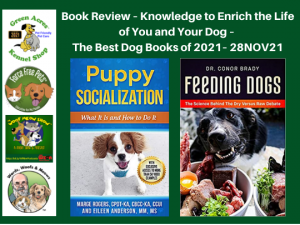 < A version of this article was published in the December 2021 issue of Downeast Dog News>
< A version of this article was published in the December 2021 issue of Downeast Dog News> for knowledge. It was a gift given out of love, knowing that it had the potential to benefit not only me but those around me. I believe it was the greatest gift I have ever received. It has nurtured my life-long love of learning, a character trait essential for any professional. What we have learned about dogs and cats in the last 30 years is amazing, and if you haven’t been keeping up, you are out of date as much of what we thought we knew has been proven incomplete or wrong.
for knowledge. It was a gift given out of love, knowing that it had the potential to benefit not only me but those around me. I believe it was the greatest gift I have ever received. It has nurtured my life-long love of learning, a character trait essential for any professional. What we have learned about dogs and cats in the last 30 years is amazing, and if you haven’t been keeping up, you are out of date as much of what we thought we knew has been proven incomplete or wrong. puppy, or is contemplating getting a puppy. It is available as a paperback or in multiple e-book formats. It is available as a paperback or in multiple e-book formats.
puppy, or is contemplating getting a puppy. It is available as a paperback or in multiple e-book formats. It is available as a paperback or in multiple e-book formats. to socialize their puppy, thus helping them have a great life together. In addition to the easy-to-read text and beautiful photographs, the book includes links to over 50 online videos. Note, it is easiest to access those videos and other online resources from one of the e-book editions.
to socialize their puppy, thus helping them have a great life together. In addition to the easy-to-read text and beautiful photographs, the book includes links to over 50 online videos. Note, it is easiest to access those videos and other online resources from one of the e-book editions.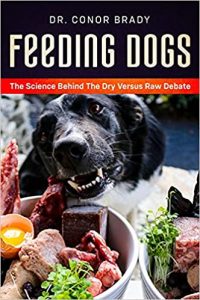 health. Dr. Brady spent 10-years examining what the scientific literature tells us about canine nutrition answering such questions as: is the dog a carnivore or omnivore, what are the problems with feeding kibble, why are so many people pro-kibble and anti-fresh food despite evidence to the contrary, and how to feed a dog a species-appropriate diet for optimal health. In addition, you will find a comprehensive reference list to the peer-reviewed scientific research supporting the author’s conclusions at the end of each section.
health. Dr. Brady spent 10-years examining what the scientific literature tells us about canine nutrition answering such questions as: is the dog a carnivore or omnivore, what are the problems with feeding kibble, why are so many people pro-kibble and anti-fresh food despite evidence to the contrary, and how to feed a dog a species-appropriate diet for optimal health. In addition, you will find a comprehensive reference list to the peer-reviewed scientific research supporting the author’s conclusions at the end of each section. every penny for those who understand that proper nutrition is the foundation of physical, mental, and emotional health. In my opinion, Feeding Dogs should be required reading for every student of veterinary medicine and recommended to every pet parent interested in optimal nutrition.
every penny for those who understand that proper nutrition is the foundation of physical, mental, and emotional health. In my opinion, Feeding Dogs should be required reading for every student of veterinary medicine and recommended to every pet parent interested in optimal nutrition.
 Podcasts from The Woof Meow Show
Podcasts from The Woof Meow Show












